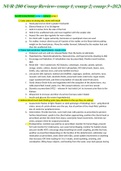NUR 280 Comp Review- comp 1, comp 2, comp 3 -2020
Nur280 Comp Review- comp 1, comp 2, comp 3
1. Cane- place on strong side, move with weak
a. Hand grip level at client’s greater trochanter
b. Elbows flexed at 15 to 30 degrees
c. Hold 4-6 inches from the side of the foot
d. Hold in the unaffected side and move together with the weaker side
e. Inspect the cane tips regularly for worn rubber
f. For client with 1 upper extremity, hemicanes or quadripod canes are used
g. For walker, instruct client to put all 4 points of the walker on the floow before putting
weight on the hand pieces. Move the walker forward, followed by the weaker foot and
then the unaffected foot.
2. Tumor lysis syndrome- hyperkalemia; cloudy urine
a. Potassium and uric acid are released faster than the body can eliminate
b. Hyperkalemia, Hyperphosphatemia, Hypocalcemia, and hyperuricemia (leading to AKI)
c. Encourage oral hydration; IV rehydration may be prescribed; Monitor renal function;
I&O;
d. Renal diet – low in potassium; NO (banana, cantaloupe, avocado, potato, spinach,
orange, raisins, salmon, beans) and low in phosphate; NO (dairy foods, beans, nuts,
lentils, cola, oatmeal, bran, and some bottled iced tea)
e. Low purine diet (spinach, seafood and shellfish, asparagus, sardines, anchovies, tuna,
mussels, red meat, duck, alcoholic drinks, preserved meats (cold cuts), organ meats,
sugar sweetened foods, and limit consumption of naturally sweet fruit juices.
f. Good choices (fresh fruits and vegetables with the exception of the above items, rice
milk-unenriched, bread, pasta, rice, fish (except salmon), corn and rice cereals
g. Diuretics as prescribed (HTCZ – releases K+ but holds Ca+) to increase urine flow to the
kidneys
h. Allopurinol to increase secretion of purines (increase water intake)
i. Insulin and glucose (for severe hyperkalemia)
3. Retinal detachment-dark floating spots (pay attention to the eye they are asking)
a. Assessment: flashes of light, floaters or dark spots(sign of bleeding), incre - asing blurred
vision, sense of curtain drawn over the eye, loss of portion of the visual field, painless
loss of central or peripheral vision.
b. Intervention: Provide bed rest, cover both eyes with patches as prescribed to prevent
further detachment, speak to the client before approaching, position the clients head as
prescribed, protect the client from injury, avoid jerky head movements, minimize eye
stress, prepare client for surgical procedures
c. Postoperative: maintain eye patches as prescribed, monitor for hemorrhage, prevent
N/V and monitor for restlessness, can cause hemorrhaging, monitor for Sudden sharp
eye pain (notify HCP), encourage deep breathing but avoid coughing, provide bed rest,
position as prescribed (depending on the location of the detachment), administer eye
medication as prescribed, assist client with ADLs, avoid sudden movements or anything
that increases IOP, limit reading for 3 to 5 weeks, avoid squinting, straining, and
constipation, lifting heavy objects, and bending from the waist, wear dark glasses during
, the day, and patches during the night, encourage follow-up because it may occur in the
other eye.
4. Chest tube- bad if drainage is >100ml/hr
a. Gentle bubbling in the suction chamber
b. Water seal chamber tidaling is normal during inspiration and expiration, small bubbling
but not continuous
c. Needs to be placed lower than the patient
d. Occlusive sterile dressing at the insertion site
e. Do not strip or milk tubing unless instructed by HCP
f. Have a clamp and occlusive dressing at the bedside at all times
g. Encourage coughing and deep breathing
h. Never clamp tubes without HCP prescription
i. If drainage system cracks or break, place tube on sterile water, then replace with new
system
j. When removing tube instruct client to deep breath and hold it, or take a deep breath
and bear down (valsalva maneuver). Dry sterile or petroleum gauze dressing is taped.
k. If the chest tube is pulled out, pinch the skin opening together (close it), then apply an
occlusive dressing then taped with overlapping pieces of 2 inch tape and notify HCP.
5. Diverticulosis- high fiber diet/ Diverticulitis- low fiber diet
a. Outpouching or herniation occurring commonly in the sigmoid colon
b. Watch for rigid board like abdomen, rebound tenderness, guarding of abdomen,
increasing temp and chills, pallor, restlessness, tachycardia, and tachypnea (Peritonitis)
c. Assesment: N/V, left lower quadrant pain that increases with coughing, straining or
lifting, elevated temp, flatulence, cramplike pain, blood in stools, palpable tender rectal
mass
d. Interventions: During acute phase – bed rest, maintain NPO or provide clear liquids as
prescribed. Introduce fiber containing diet gradually when inflammation has resolved.
Administer antibiotics, analgesics, and anticholinergics to reduce bowel spasm as
prescribed. Instruct client to refrain from lifting, straining, coughing, bending that
increases intra-abdominal pressure.
6. 70/30- 70 NPH/30 regular insulin
a. When mixing NPH and regular
i. Roll NPH gently (do not shake)
ii. Wipe both vials with alcohol wipes
iii. Inject air to cloud (NPH) and then inject air to clear (regular)
iv. Pull from clear (regular) and then pull from cloudy (NPH)
b. Onset of 70/30 is 30 minutes and peak is 2-12 hours.
c. Make sure client eats within 30 minutes of taking insulin
d. Watch for signs of hypoglycemia 70 mg/dL (irritability, cool, clammy, tachycardia,
palpitations, sweating, tremors, later signs involves changes in LOC and impaired
coordinations up to loss of consciousness and seizures)
e. Treatment for hypoglycemia – 4 tsp of sugar, 4 sugar cubes, 1 Tbsp honey, ½ cup fruit
juice or non-diet soda, 6 saltine crackers, 3 graham crackers, 6 to 10 life savers or hard
candy




